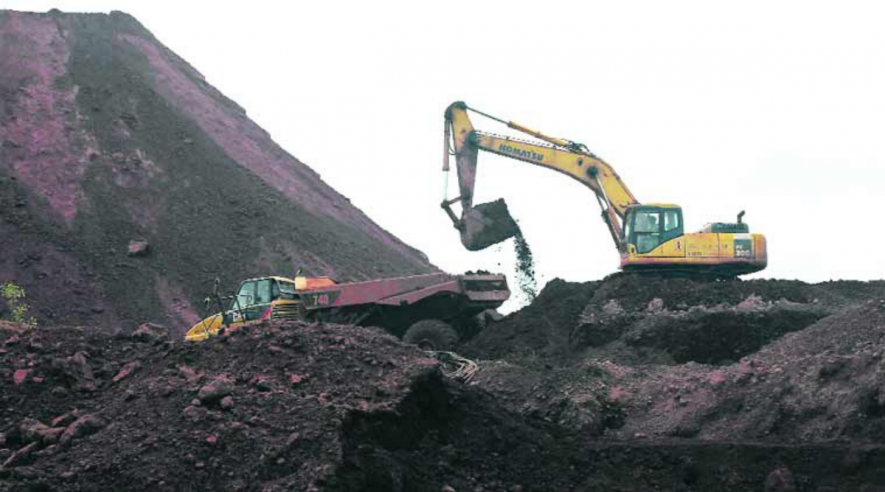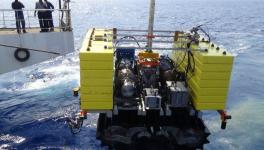MMDR Amendment: States, People, Future Generations to Lose Crores

Image Courtesy: The Indian Express
Mineral wealth worth lakhs of crores will be lost due to a proposed amendment to the Mines and Minerals (Development and Regulation) Act, 1957, (MMDR Act). A change in the definition of the average sale price (ASP) of mineral ore proposed in a recent consultation by the ministry of mines will result in a significant discount on the price states receive for their mineral wealth. States as trustees of mineral wealth for the people, especially future generations, are required to ensure zero loss in the trust wealth—however, the rules are set and bent by the Centre.
Background
The National Mineral Policy (NMP), 2019, states: “There is a need to understand that natural resources, including minerals, are a shared inheritance where the state is the trustee on behalf of the people to ensure that future generations receive the benefit of inheritance.”
Put simply, it means that minerals are the property of future generations—our collective family gold. The state is a trustee, and all of us are the joint custodians of this property. Mining usually results in the sale of the extracted minerals with royalties and auction premia received as the sale consideration. The miner is merely an outsourced service provider—a contractor who converts mineral wealth into financial form.
If mining is the sale of the family gold, the goal of the state as the mineral owner is zero loss in value (after extraction costs and a normal profit for the miner). As the Supreme Court pointed out in the Meerut Devt. Authority vs Association Of Management on April 17, 2009: “Whenever the government or the authorities get less than the full value of the asset, the country is being cheated; there is a simple transfer of wealth from the citizens as a whole to whoever gets the assets ‘at a discount’.”
The NMP further states: “State governments will endeavour to ensure that the full value of the extracted minerals is received by the state.” But there’s a catch. While Entry 23 of the State List in the Constitution states that “regulation of mines and mineral development subject to the provisions of List I with respect to regulation and development under the control of the Union”, it is trumped by Entry 54 of the Central List, which gives superior authority to the Centre for “regulation of mines and mineral development to the extent to which such regulation and development under the control of the Union is declared by Parliament by law to be expedient in the public interest”. The MMDR Act was passed pursuant to these powers available to the Centre.
State Government’s Mineral Sale Proceeds
Traditionally, states received royalties and dead rent (insignificant). The rates for royalty (for major minerals) are reflected in the Second Schedule of the MMDR Act. As the Hoda Commission, 2006, pointed out: “For calculation of royalty, three systems are prevalent worldwide. These are quantity based or rate per tonne, ad valorem or percentage of revenue, and profit based or percentage of profit.” At that time, out of the 51 minerals in the schedule, 29 attracted ad valorem rates while 22 still attracted specific rates expressed as rupees per tonne. The Hoda Commission recommended a move to an ad valorem basis for royalty for a number of important minerals, including iron ore. Over time, most minerals have moved to an ad valorem basis.
Ad valorem rates are based on the concept of a pit head price—the market price of the mineral at the exit gate of the mine. This price can vary and is subject to various manipulations. Consequently, the Indian Bureau of Mines (IBM) calculates an average sale price (IBM ASP) for the ore. For calculating ad valorem royalty, the IBM ASP is used instead of the actual price received at the mine gate. The royalty amount is simply IBM ASP times the royalty rate as specified for that mineral, ore grade and state in the Second Schedule of the MMDR Act.
Centre Vs State
We see here the conflicts of interest. The state as the mineral owner has a fiduciary responsibility to ensure zero loss and get the full value of the extracted mineral—echoed by the NMP. The miner, of course, wants to pay as little as possible for the minerals he extracts. The centre is keen on ‘Atmanirbhartha’, the availability of domestic minerals in the economy, and constitutionally has the authority to regulate and develop minerals in the public interest, including setting the price (royalty rate and auction terms) at which miners can buy minerals from the state. The lower the price of the mineral, the greater the profit of the miners and the more the miners will extract.
The NMP does propose a safeguard against the centre unilaterally forcing states to set rates artificially low: “A unified authority in the form of an inter-ministerial body under ministry of mines, with members like the ministry of coal, MoEarth Sciences, MoEFCC, the ministry of Tribal Affairs, ministry of rural development, ministry of Panchayati Raj, ministry of steel, including state governments, shall be constituted to institutionalise a mechanism for ensuring sustainable mining with adequate concerns for the environment and socio-economic issues in the mining areas, and to advise the government on rates of royalty, dead rent, etc.”
Reducing Losses
It has been clear for some time that the royalty regime did not achieve zero loss—the price was too low. Following a slew of Supreme Court judgements on the alienation of natural resources, the MMDR Act was amended in 2015 to provide for mandatory auction of leases. Winners at the auctions would pay royalty plus an ad valorem auction premia.
For example, the royalty rate for iron ore is 15%. If the winning bid was 35%, the bidder would pay the state government, as mineral owner, 50% (15%+35%) of the IBM ASP. The reasoning is straightforward. Auctions would ensure that the minerals are sold for fair market value. At the same time, existing leases were extended for a minimum of 50 years from the original grant and longer in some cases. The rationale was to avoid disruption to the economy.
The auction results are instructive. Since 2015, 184 mineral blocks have been auctioned. The ministry of mines used to publish estimates of additional amounts that states would receive as a consequence of the auctions but has subsequently discontinued the practice. After 104 auctions, the summary by the ministry of mines shows that states will receive by way of auction premia 5.80 times that they would receive as royalty. In other words, if a pre-auction lease paid Rs 1 for minerals, the auctioned lease would pay Rs 6.80. A stunning success for which the Centre should take all credit.
Table 1: Mineral Sale Proceeds for a state government
Unfortunately, the ministry of mines and its advisor SBI Caps did not seek the advice of Robert Wilson and Paul Milgrom, the winners of the 2020 Nobel Prize for their work on the theory of auction design. The auctions resulted in a situation where around 2,000 mineral leases were paying only royalty (because their lease periods had been extended) while the newly auctioned leases were paying nearly seven times those amounts. The pre-auction leases can simply undercut the auctioned leases. Naturally, few auctioned leases started operating.
In desperation, the ministry of mines has piloted a number of changes to the Act, rules and regulations to encourage the extraction of more minerals. Among other things, it enabled holders of captive leases, who were earlier barred from selling on the open market, to supply excess production by paying an intermediate price of up to 3.5 times the royalty. This has further undercut the winners of auctioned blocks. These changes were made without the constitution of the inter-ministerial mechanism, including states advising the government on rates of royalty, dead rent, etc.
In parallel, the bidders in the auctions have also ignored plain economics and bid absurdly high ad valorem rates to win the auction. For example, one iron ore mine was auctioned for a premium of 154% of IBM ASP. The winner was committing to pay 154%+15% royalty, or 169%, of IBM ASP to the mineral-owning state. This can only be rational if the expectation is that it would be possible to turn a profit by illegal mining, illegalities in mining such as under-reporting the grade of ore or that the rules of the game can be changed subsequently.
The MMDR Amendment
- A hidden loss for states, their people and future generations
Now, the ministry of mines has conducted a public consultation where it proposes to change the basis of calculation of royalty and auction premia. What it does not say is that its proposal will amount to a massive hidden discount for mineral leaseholders, whose value will go into lakhs of crores of rupees. What is being proposed?
Quite simply, it is redefining the ASP as follows: Proposed ASP = IBM ASP – royalty – DMF – NMET – other items that may be notified. Royalty, auction premia, DMF and NMET will be charged at the same rates but on the Proposed ASP.
Let us consider iron ore. For a pre-auction lease, royalty is 15%, DMF is 30% of royalty and NMET is 2% of the royalty for a total of 19.8%. So, if this has to be subtracted from IBM ASP, the Proposed ASP reduces to 83.5% (100/1.198), or a discount of 16.5%. The mineral sale proceeds reduce from Rs 15 to Rs 12.8.
For an auctioned lease, royalty and NMET are unchanged while DMF is 10% of royalty for a total of 16.3%. Hence, the proposed ASP reduces to 85.6% (100/1.168), or a discount of 14.4%. If we assume the auction premia is 86.2%, which is the average of the first 104 auctions, we find that the mineral sale proceeds of royalty + auction premia reduce from Rs 101.2 to Rs 86.6, a reduction of 14.4%.
The rubber hits the road when we consider the total hidden discount. From the first 104 auctions, an approximate estimate is that the states will lose Rs 115,934 crore by way of mineral sale proceeds. Further, the amount going to the District Mineral Foundation for the benefit of mining-affected people and areas reduces by Rs 1,704 crore and funding for mineral exploration through the NMET declines by Rs 341 crore.
This is not half of it. We haven’t considered the balance of 80 auctioned leases for which information is not available. And the overwhelming majority of mineral extraction today is through pre-auction leases, which already benefit significantly as they only pay a royalty or a slight premium.
-
Why it is illegal?
Arguably, this violates a variety of constitutional provisions, notably Article 14 (equality). This proposal bypasses the inter-ministerial committee, including states, which is yet to be constituted, violating the NMP. There’s been a clear violation of the Right to Information Act, 2005, whose Section 4(1)(c) states: “Every public authority shall publish all relevant facts while formulating policies or announcing decisions which affect the public.”
This also violates administrative law. The Pre-Legislative Consultation Policy of the government sates: “The department/ministry concerned should publish/place in the public domain the draft legislation or, at least, the information that may inter alia include a brief justification for such legislation, essential elements of the proposed legislation, its broad financial implications, and an estimated assessment of the impact of such legislation on environment, fundamental rights, lives and livelihoods of the concerned/affected people, etc. Such details may be kept in the public domain for a minimum period of 30 days for being proactively shared with the public in such manner as may be specified by the department/ministry concerned.” No broad financial implications have been provided. For obvious reasons.
What the Centre gives the states, it can also take away. Federalism is being choked by the series of ad hoc amendments—each one designed to meet serious problems created by the 2015 changes to mining laws. The root cause is a flawed system where different prices exist for the same commodity. Throwing the wealth of states at the problem will not fix it. States should demand that the Centre ensure that states, at the very least, receive the full value of their minerals upon extraction.
The writer is with the Goa Foundation. The views expressed are personal.
Get the latest reports & analysis with people's perspective on Protests, movements & deep analytical videos, discussions of the current affairs in your Telegram app. Subscribe to NewsClick's Telegram channel & get Real-Time updates on stories, as they get published on our website.
























